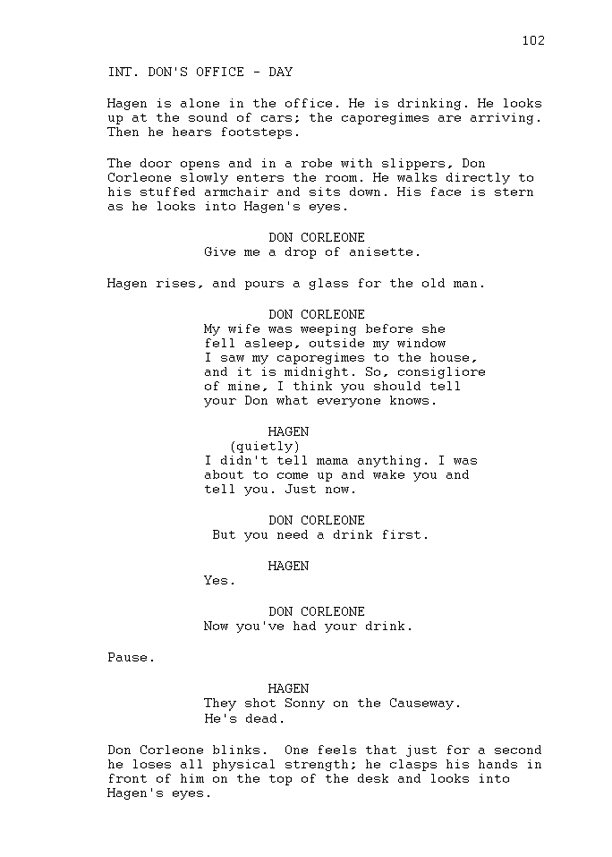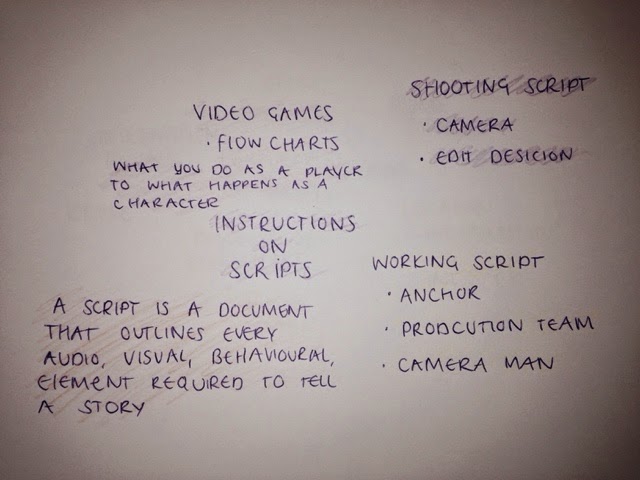All scripts are written in 12-point Courier, or a slight variation (Courier New or Courier Final Draft, for instance). This is because Courier is a fixed-pitch font, meaning each character or space is exactly the same width.
Scripts are used by all sorts of people such as actors and actresses, directors, and game coders. There are also different types of scripts that include different information in order to work.
Screenplays for example include character descriptions because the actors need to be able to understand that character as a person, what they look like, how they act and their qualities and history This way an actor can grasp a real feel for their character and present this correctly to the audience in performance.In the example screenplay scripts I found they didn't include a character description, this is because I took sections of the script from the middle of the scene, and the character descriptions would be at the beginning. A computer game script includes a flow chart in order to show the possible decisions a character could make at any given point in the game and what the players decision could lead too. So for example the video game for The Walking Dead allows you to decide what your next move should be, and for your move there will be consiquences. For example if you make a decision to attack the zombies a possible member of your group may be captured or killed, whereas if you choose to hide from the zombies you could stay safe, or one of your group may be found and taken.
The presenters and characters sections of the scripts are justified to the center straight away making it clear and easy to read and to show their dialogue. The characters name will also be in capital letters so the actors will straight away know who is talking.
A typical convention of a video game script is that it includes a synopsis which includes moving images and a voice over before the game begins, setting the scene and allowing the audience some back ground information on the game before they start to play and what the overall objective is and what needs to be completed.
Instead of a synopsis, film scrips include stage and location directions telling the actors where the scene will be set, what is will look like and if it will be busy or quite.For example in the film script I found it begins with "Hagen is alone in the office. He is drinking..." which tells the actor he will be sat in an office based set drinking a beverage. It will tell them when they are due off stage, if there are any props needed and the type of body language they should use. It also allows them to know others actors that will be present at this time which is all very important so that when action is called the dialogue and acting flows in the correct order.
Sound effects are also present on a script but are justified to the left of the scrip all in capital letters and usually underlined. In the radio script there is a sound effect located roughly half way down, it states "sound: SFX of the room. there is silence between Catherine and Micheal and in the background we can just make out a TV which is turned on." this allows the actors to know when to be silent and what is going on else where in the scene.
Being underlined separates them from the dialogue and also makes a clear distinction between the two.
There are 3 main different types of mode of address than can be present in scripts which include Peer to Peer, Teacher to Pupil and Parent to Child. Each of the 3 different modes of address are for different situations which are recognized by the audience.
The common stage directions in screenplays includes titles, a synopsis, location (INT. EXT.), has character names bold and capitalized, has intonation in brackets under character name, and contains editing transitions such as cut to and fade in and out.
In the drama script the location is stated (A heated argument is heard from above, muffled through the floor of Rose's bedroom). Another example is in the film script at the top it says ( INT. Don's Office - Day ) telling us the location and the time of day.
NARRATIVE STRUCTURE
There are 4 different types of narrative structure in script writing.
1. Single stranded
This means that the story only follows one character. For example, in a video game, you play as one character within a story. Another example is the film Superman. Although there is other characters, the story follows one particular person. This gives the audience full control over their chosen character and makes them feeling like they are incomplete trust of the game.
2. Multi-stranded
This means that the story follows more than one character. An example of this is anything drama based such as soaps like Eastenders. The programme is filmed in different locations following different characters and story lines. This has a dramatic irony effect on the audience as we know what is happening in each different place during the soap however other characters may not know this. For example we know that Stacey has just kissed Max in her bedroom yet Bradley is still yet to find this information out.
3. Linear
This means that the story is in chronological order. An example of this is a video game. The game will start with a synopsis video which informs the player of the aim of the game.
4. Non-linear
This means that the order of the story isn't in any order yet still makes sense. Examples of this are films such as Shutter Island which starts from the middle and works its way throughout the past and present.
5. Running Order
A running order would be included in live broadcasts, television and radio so that each person knows when to talk, when to move on and off set and on the radio when a song will be played or when a caller is live being interviewed.
GENRE
TV Drama scripts tend to be fiction whereas documentaries are non-fiction. This is because a TV drama is purley to entertain where as a documentry is made to inform and give information and so uses real life information and true facts.
Video games are a made up story meaning they are fiction. This is because they are made for people playing them to have time out from the real world, following Blumer and Katz Uses & Grats Theory.
Screenplays are usually fiction although sometimes they can be based on real life events such as the film Titanic was made to entertain but also teach and educate people on what happened.
TV News broadcasts are always non-fiction as they are informing an audience.
Interview scripts usually use probing questions which are non-fiction although they can sometimes be rumours which are made up making them fiction.An example of this would be a chat show such as Fashion Police as this uses non-fiction talk about life but also may talk about rumours that occur in the celebrity world making it fiction.
TARGET AUDIENCE
The target audience for TV drama scripts is middle-aged women usually mothers who enjoy the voyeuristic values of drama. They are usually of ABC1 demographics meaning they have a fair bit of disposable income. The age of TV drama scripts varies depending on watershed times. If the drama is broadcast at 9pm or later, it is intended for a more mature audience.
The target audience for video games are usually teenage boys who enjoy the escapism of being in a virtual world. Although they don't earn money themselves, they are dependent on their parents who are usually of ABC1 demographics meaning they have disposable income to spend on games. Games are given a PEGI rating which tells us what age the specific game is intended for. These ratings are 3+ 7+ 12A 12+ 15+ and 18+.
The target audience for screenplays vary throughout the genres. For example horror films will have a high teenage audience whereas cartoons will have a young audience and parent audience.This is due to content in the film. For example a cartoon such as Frozen will be PG as it will include no sexual references, innaproprite language or unseen images however a film such as Paranormal Activity which includes strong language, thrilling scenes and deep tension throughout. Films are given an age rating which indicates what age the audience has to be. The options are PG, 12A, 15 and 18.
The target audience for TV news broadcasts is also very varied as anyone is permitted to watch the news although adults are usually more interested.
As I am creating a TV News Broadcast, here is a more in-depth analysis.
The style and content of a TV News Broadcast is written in a formal manner as they are story telling serious non-fiction headlines.
Although scripts follow a narrative structure, TV News Broadcast is different. It follows a running order within the studio with a presenter. However each story tells the audience what, when, where, why and how things have happened, informing them on the news.
The genre of TV News Broadcast is non-fiction as real things are being reported.
The target audience for TV news broadcasts is also very varied as anyone is permitted to watch the news although adults are usually more interested. The news is on throughout various times of the day such as 8am, 6pm and 10pm. This is to keep the audience up to date with the latest news.
Different abbreviations are used on TV News Broadcast scripts which included:
N.I – No video support is shown and is read by the anchor/host (30 seconds long).
SILENT - presenters voice is linked to the visuals and is the only sound played.
NATSOT – presenters voice is linked to visuals and visuals have natural sound.
SOT – sound that is on a tape for example a voice over.
V.O – a voice over; presenter narrating visuals.
EXT. - exterior, outside
INT. - interior - inside









